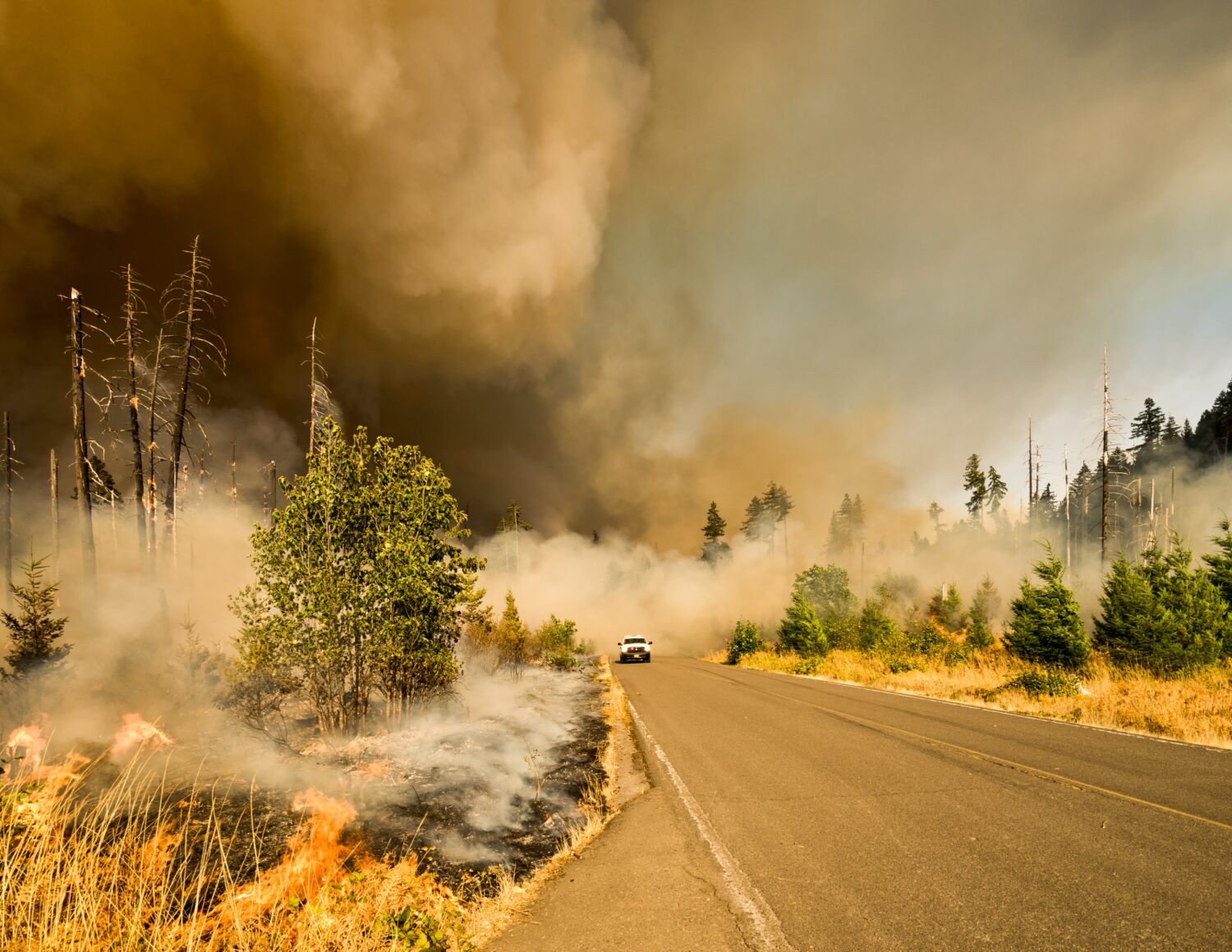A hot summer of wildfires underscores the global urgency of governmental action
 Waldbrände werden eine zunehmende Bedrohung für die Umwelt und Menschen. Foto: unsplash / Marcus Kauffman
Waldbrände werden eine zunehmende Bedrohung für die Umwelt und Menschen. Foto: unsplash / Marcus Kauffman
Die Waldbrandsaison des Sommers 2023 in Nordamerika und Europa ist von Extremen geprägt. Steven Hill zeigt in seinem Meinungsbeitrag auf, wie sich die unterschiedlichen politischen Systeme in den USA und der EU auf den Umgang mit der Klimakrise auswirken.
by Steven Hill
The summer is barely halfway over, and already extreme heat has rattled nerves around the world. From Italy, Greece, Spain and Portugal to Canada, California and other locations around the world, the increasingly severe impacts of global warming, including massive and unpredictable wildfires, have become disturbingly frequent.
I still vividly remember the morning of 9 September 2020, when I woke up and stared out my bedroom window in San Francisco at the sight of an ominously orange glowing sky. It looked so ashy and dim that for a moment I thought the sun hadn’t come up. Then I saw the clock, and realized that the eerie orange hue was being caused by a thick haze of wildfire smoke that had fallen over the city from hundreds of miles away in Northern California. This made me shiver with alarm; I knew it was a forewarning of the day of reckoning to come.
This summer the New York City skyline was visited by its own orange sky day, the result of blazing wildfires hundreds of miles away across the Canadian border. Borders will not save anyone from this menacing global threat of climate change. Thousands of wildfires across Canada have scorched more than 30 million acres, an area bigger than North Korea, and more than four times the acreage burned in a typical wildfire season. Many towns have been evacuated and it’s only halfway through the fire season.
Italy, Spain, Portugal and Greece also have faced unrelenting heat for weeks, but the European Space Agency has warned that the current heat wave is only the beginning. In Italy, which has been particularly hard hit, temperatures in many cities have soared to 40 degrees Celsius (104 degrees Fahrenheit) and higher, and deadly wildfires have ravaged the south. Climate scientist Hannah Cloke compared the effect to that of a giant oven swallowing the Mediterranean.
“The bubble of hot air that has inflated over southern Europe has turned Italy and surrounding countries into a giant pizza oven,” she said.
Most recently, the tropical island paradise of Maui in the US island state of Hawai’i went up in flames. The resort town of Lahaina turned into a towering inferno in which people had to flee into the nearby ocean to save themselves. The Maui death toll has surpassed 110 people, with more dead likely as firefighters search through the rubble. It is the deadliest wildfire in the US in a century, even more deadly than the Camp Fire in California in 2018, which killed 85 and destroyed an entire town, turning it into ashes. The only thing left standing were the remnants of brick chimneys. Ironically, the name of the obliterated town was Paradise.
In 2017, California wildfires caused $12.1 billion in damage, the highest in state history. In 2020, fire suppression costs surpassed $1 billion for the first time, as fighting fires drained the public taxes needed for education and health care.
Across the planet, this past June was the hottest month on record, according to the European Union’s Copernicus Climate Change Service. It was accompanied by record high ocean temperatures and record low levels of Antarctic ice. Unlike previous years, the nights don’t always cool down and droughts have intensified, even as computer models predicting fire behavior have become unreliable. The first week in July was the hottest week on record, according to data from the World Meteorological Organization. These heatwaves have led to many premature deaths, especially among the elderly.
All of the evidence makes it clear that the planet is in what the World Meteorological Organization has described as “uncharted territory.” Dr. Tedros Adhanom Ghebreyesus, the head of the World Health Organization, has urged world leaders to “act now” on the climate crisis.
So how are the world’s governments responding to this unprecedented challenge?
Climate change leaders – and foot-draggers
Environmental researchers at Yale and Columbia universities regularly rank the world’s nations according to their levels of eco-friendliness. The 2022 Environmental Performance Index (EPI) graded 180 countries, from Albania to Zimbabwe, on 32 key sustainability indicators, taking into account the latest data on critical things such as CO2 emissions, air and water quality and other public health factors. A few findings of the report stand out.
First, the world’s top fifteen most green, climate-conscious countries are all in Europe. In fact, 23 out of the top 25 green countries are European, with the other two countries in the top 25 being Japan (ranked 25th) and Australia (ranked 17th). Europe also holds 29 out of the top 35 spots. The European continent is leading the world.
Meanwhile, China (160), Russia (112) and India (180) are among the biggest carbon polluters. Even more disappointing, the United States is ranked only 43rd, right between the developing nations of Namibia and Dominica. That’s a decline from the 2020 EPI, when the US was ranked 24th. The world’s wealthiest nation is projected to fall far short of its net-zero greenhouse gas emissions targets established by the 2021 Glasgow Climate Pact. In fact by 2050, over 50% of global emissions are expected to come from just four countries – China, India, Russia and the US.
Opinion polls demonstrate that two-thirds of Americans believe that the US government should do more on climate. Unlike the authoritarian states of China and Russia, the US is a representative democracy, which in theory is supposed to be responsive and accountable to “the people.” So why isn’t the US government responding by following through on the public’s beliefs and commitments regarding climate change? This is perhaps one of the most significant policy dilemmas of our times.
The value of robust democracy
To understand Europe’s leadership in climate policy, it is helpful to understand that Europe’s vibrant democracies are quite different than the US, with very distinctive robust institutions and practices. Research by political scientists like Arend Lijphart and G. Bingham Powell has demonstrated that European democracies are far more representative of the varying political perspectives in society, and therefore are more reflective of a society-wide consensus than has been possible in the US.
Nearly all European nations use proportional representation electoral systems, as well as some degree of public financing of campaigns, free media time for political parties and candidates, inclusion in televised debates, and universal/automatic voter registration. These in turn result in a number of other good government features, such as multi-party democracy, higher voter turnout, more robust political debate, and the ability of everyday citizens to make sense of their political world (what political scientist Henry Milner has called “civic literacy”).
Multi-party democracy creates dialogue between the dominant mainstream parties and the junior parties, between the political center and the flanks of the spectrum. Minor parties in Europe mostly are welcomed for the valuable role they play as the “laboratories for new ideas,” challenging and stimulating voters, the media, and the major parties to think outside the conventional political box. In the short run that political dynamic can sound noisy and untidy, but in the medium and long terms it allows a much fuller airing of the issues and achieving a broader consensus, and a greater effectiveness to pass policy that reflects that consensus.
When it comes to environmental issues, pro-environmental parties across Europe have played an indispensable role. They have championed positions that initially had little public support because they were ahead of their time; now those same positions are the core of mainstream European politics, having been adopted by the major parties, even the conservative parties, as those positions became popular due to the increasingly obvious impacts of global warming and other environmental threats. European democracies are not perfect and have their own challenges. But on the whole, many have performed more effectively than most other governments.
A failure of America’s two party „winner take all“ system
Representative democracy works very differently in the United States. Voters are mostly bunkered down in non-competitive, one-party districts and states where their frame of reference is not even of a two-party system, but of one party that dominates their entire region. Smaller parties are weak and unfunded, and rarely elect officeholders. Political monocultures result, where debate becomes all but frozen.
Without proportional representation, public financing, free media time and universal/automatic voter registration in the US, forward-looking voices have a hard time breaking through the duopoly and gaining a place at the table. Complicating matters further, in the U.S. Senate it takes a super-majority of 60 out of 100 Senators to pass legislation, due to a process rule known as the “filibuster” which can be used to terminate debate on any legislation. The US political system is still rooted in its antiquated, 18th-century origins, and that reality has led to a destructive form of “minority rule” in which a right wing Republican party led by Donald Trump has been able to kill environmental policy or any attempts to reach consensus on controversial issues.
Last year, President Joe Biden’s administration made progress with its passage of federal legislation that will spend an $369 billion on energy and climate change. That amounts to the largest investment in clean energy to combat climate change in US history. With the incentive of federal tax credits, companies have announced nearly 200 new clean energy projects totaling more than $110 billion in investment.
But in the 2022 elections, Republicans won back control of the US House. So the lack of a truly representative democracy that translates public opinion into effective policy will continue to hamper US efforts. Given the crucial role that America plays in the world, this lack of policy responsiveness is perhaps the greatest threat to the world’s future.
Steven Hill ist Herausgeber und Chefautor von DemocracySOS und ist der Autor des Buches “Europe’s Promise: Why the European Way Is the Best Hope In an Insecure Age.” Sie können ihn unter @StevenHill1776 kontaktieren.
